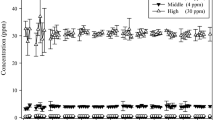Abstract
In acute and subchronic inhalation studies rats were exposed to trichloroethylene. During the 4-h exposures the concentration was about 50 ppm to 3160 ppm and more, and in the 14-week study (8 h/day) within the range of the MAC (50 ppm). The behavior of trichloroethylene and its metabolites (chloral hydrate, trichloroethanol and trichloroacetic acid) in the expired air, blood and urine was investigated. For this purpose, analytical methods were developed.
With the exception of elevated liver weights, the exposure to a trichloroethylene concentration of 55 ppm over a period of 14 weeks did not cause any pathological changes. The liver enlargement as a consequence of an enzyme induction is discussed. Trichloroethylene was not detectable in the blood, and the concentrations of trichloroethanol and chloral hydrate were not altered significantly. The urinary trichloroethanol excretion increased until the 10th week and then decreased slowly. In contrast, the trichloroacetic acid remained fairly constant. Corresponding results of the ratio TCE:TCA were found.
Zusammenfassung
Ratten wurden in akuten und subchronischen Inhalationsversuchen Trichloräthylen exponiert. Bei den 4stündigen Expositionen waren die Konzentrationen ca. 50 ppm bis 3160 ppm, im 14-Wochenversuch (täglich 8 Std) im MAK-Bereich (50 ppm). Das Verhalten von Trichloroäthylen und seiner Metabolite (Chloralhydrat, Trichloräthanol, Trichloressigsäure) in Atemluft, Blut und Harn wurde untersucht. Dazu wurden Methoden zur analytischen Bestimmung ausgearbeitet. Mit Ausnahme erhöhter Lebergewichte ergaben sich bei Ratten nach Inhalation einer TRI-Konzentration von ca. 55 ppm über 14 Wochen keine pathologischen Veränderungen. Die Lebervergrößerung als Folge einer Enzyminduktion wird diskutiert. Trichloroäthylen konnte im Blut nicht nachgewiesen werden, die Trichloräthanol- und Chloralhydrakontzentrationen veränderten sich nicht wesentlich. Die Trichloräthanolmenge im Harn stieg bis zur 10. Woche an, um dann allmählich abzunehmen. Dagegen blieb die Trichloressigsäurekonzentration ziemlich unverändert. Entsprechend verhielt sich das Verhältnis Trichloräthanol/Trichlor-essigsäure.
Similar content being viewed by others
References
Andersson, A.: Health dangers in industry from exposure to trichloroethylene: A clinical experimental and hygienic investigation. Acta med. scand.157, 161, Supp. 323 (1957).
Betke, K., Savelsberg, W.: Stufenphotometrische Hämoglobinbestimmung mittels Cyanhämoglobin. Biochem. Z.320, 431 (1950).
Grandjean, E., Münchinger, R., Turrian, P., Haas, A., Knoepfel, H. K., Rosenmund, H.: Investigations into the effects of exposure to trichloroethylene in mechanical engeneering. Brit. J. industr. Med.12, 131 (1955).
Holzer, H., Hahn, J., Schneider, S.: Zum Mechanismus des aneroben Glukoseund Fruktose-Abbaus im Mäuse-Ascites-Carcinom. Biochem. Z.326, 351 (1955).
Henry, R. J.: Clinical chemistry. Philadelphia: Hoeber 1964.
Kimmerle, G., Eben, A.: Metabolism, excretion and toxicology of trichloroethylene after inhalation. 2. Experimental human exposure. Arch. Toxikol.30, 127 bis 138 (1972).
Niessen, H., Tietz, H., Hecht, G., Kimmerle, G.: Über Vorkommen von Sulfoniumverbindungen in Metasystox (i) und Metasystox R und ihre physiologische Wirkung. Arch. Toxikol.20, 44 (1963).
Popper, H., Mandel, E., Mayer, H.: Zur Kreatininbestimmung im Blute. Biochem.291, 354 (1937).
Reitman, St., Frankel, S.: A colorimetric method for the determination of serum glutamic oxalacetic and glutamic pyruvic transaminase. Amer. J. clin. Path.28, 56 (1957).
Schmidt, F. H.: Enzymatische Methoden zur Bestimmung von Blut- und Harnzucker unter Berücksichtigung von Vergleichsuntersuchungen mit klassischen Methoden. Internist4, 554 (1963).
Takamatsu, M.: Gefährdung der Gesundheit von Arbeitern durch Trichloräthylen-dampf. II. Trichloräthylen-Exposition bei der Materialentfettung in einer Fabrik für Fernmeldeapparate. Kumamoto med. J.15, 43 (1962).
Tanaka, S., Ikeda, M.: A method for determination of trichloroethanol and trichloroacetic acid in urine. Brit. J. industr. Med.25, 214 (1968).
Unpublished investigations of the Inst. of Pharmacol. and Toxicol., Univ. Würzburg 1964.
Wilcoxon, F.: Individual comparisons by ranking methods. Biometrics1, 80 (1945).
With, T. K.: Bestimmung von Bilirubin in kleinen Blutmengen (Cutanblut). Hoppe-Seylers Z. physiol. Chem.278, 129 (1943).
Author information
Authors and Affiliations
Rights and permissions
About this article
Cite this article
Kimmerle, G., Eben, A. Metabolism, excretion and toxicology of trichloroethylene after inhalation. Arch Toxicol 30, 115–126 (1973). https://doi.org/10.1007/BF02425929
Received:
Issue Date:
DOI: https://doi.org/10.1007/BF02425929
Key words
- Trichloroethylene
- Inhalation
- Metabolism in Rats
- Trichloroethanol, Chloral Hydrate, Trichloroacetic Acid
- Methods of Determination




